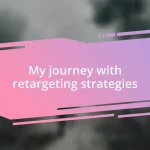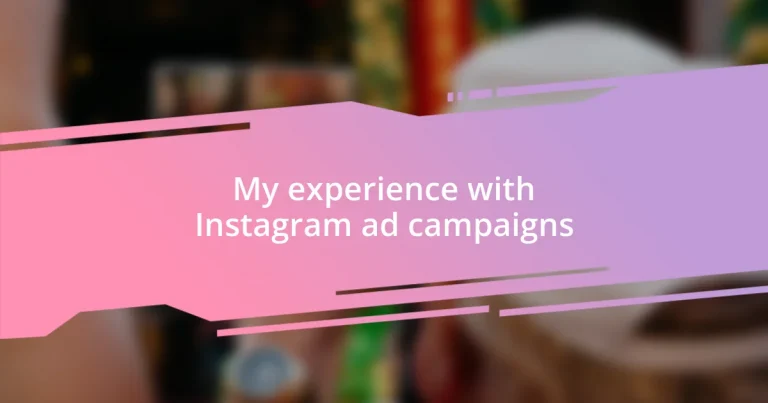Key takeaways:
- Understanding and utilizing Instagram’s diverse ad formats and targeting options significantly improves audience engagement and campaign effectiveness.
- Setting clear, specific goals and involving a team in the strategy fosters creativity and enhances campaign performance.
- Analyzing metrics, adapting strategies based on feedback, and storytelling are crucial for refining campaigns and achieving lasting success.
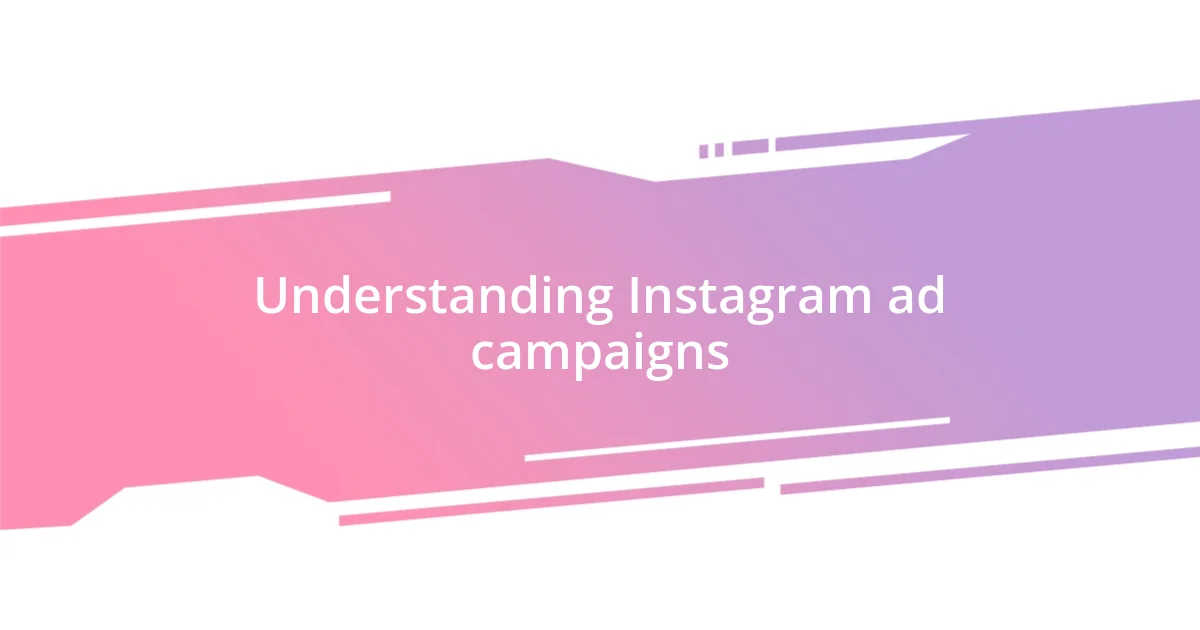
Understanding Instagram ad campaigns
Understanding Instagram ad campaigns can sometimes feel overwhelming, but breaking it down into manageable parts helps. I remember when I first started; the sheer variety of ad formats—ranging from photos to stories—left me a bit puzzled. Which one would resonate with my audience the most? Turns out, choosing the right format is key to capturing attention.
I discovered that Instagram’s targeting options were a game changer for me. Initially, I had a broad audience in mind, but narrowing it down to specific demographics and interests made a huge impact. It felt empowering to see engagement increase as I fine-tuned my audience. Have you ever experienced the thrill of connecting directly with your ideal customers?
One aspect I found particularly fascinating is how Instagram allows for quick feedback through insights. Monitoring performance metrics like reach and click-through rates can feel like having a pulse on your campaign. I often found myself analyzing data late at night, excitedly tweaking my ads based on what was working—and let me tell you, those small adjustments can lead to significant results! How do you measure success in your campaigns?
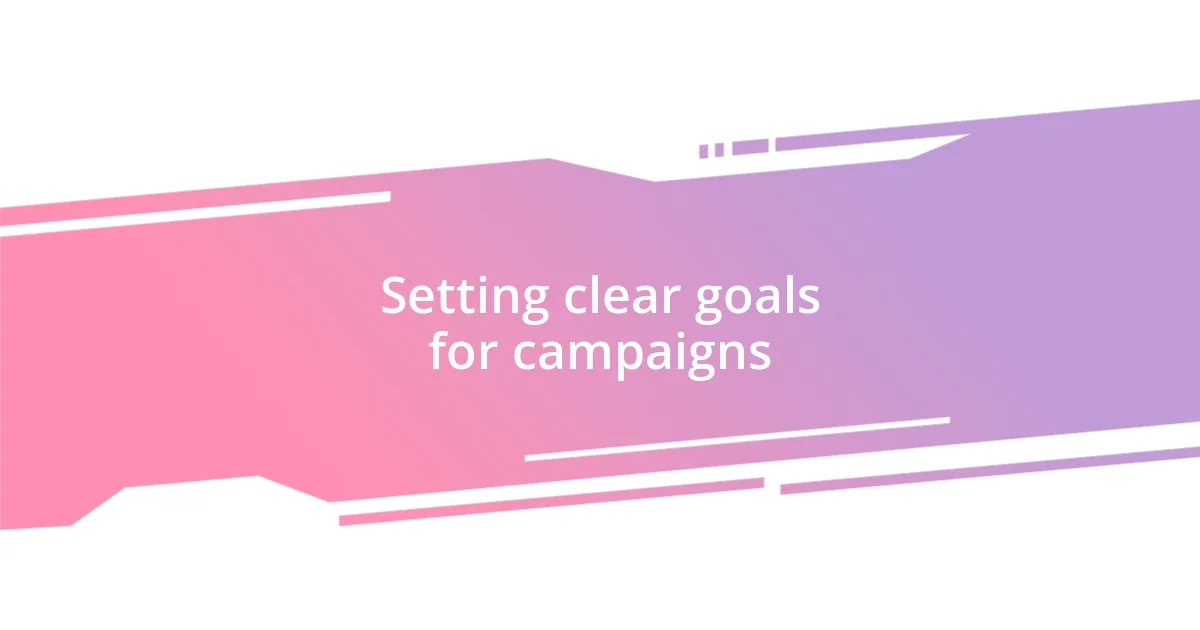
Setting clear goals for campaigns
Setting clear goals is paramount when launching Instagram ad campaigns. I learned this the hard way after a few campaigns flopped due to vague objectives. By clearly defining what I wanted—be it increasing brand awareness or driving website traffic—I saw a noticeable improvement in overall performance. Focusing on specific metrics, like a target number of clicks or engagement rates, creates a roadmap that makes the entire process less daunting.
It’s interesting to think about how different goals can change your approach. For instance, when I aimed to boost sales, I crafted ads that highlighted product benefits directly. However, when my goal was to build community engagement, my focus shifted to more relatable content that encouraged interactions. I’ve found myself often re-evaluating these goals throughout a campaign, almost like recalibrating a compass during a journey. Have you taken the time to reflect on what you truly want to achieve?
As I continued to refine my goal-setting process, I discovered that involving my team in brainstorming sessions added another layer of clarity. We would throw around ideas and sometimes challenge one another, which sparked creativity and led to surprisingly effective strategies. Engaging others not only generated fresh perspectives but also instilled a sense of shared accountability. This can make a campaign feel less like an isolated endeavor and more like a collaborative journey toward success.
| Goal Type | Description |
|---|---|
| Brand Awareness | Focus on reaching new audiences, showcasing the brand’s personality. |
| Lead Generation | Encourage sign-ups through lead magnets or exclusive offers. |
| Sales Conversion | Drive immediate purchases through specific calls to action. |
| Community Engagement | Foster relationships through interactions and relatable content. |
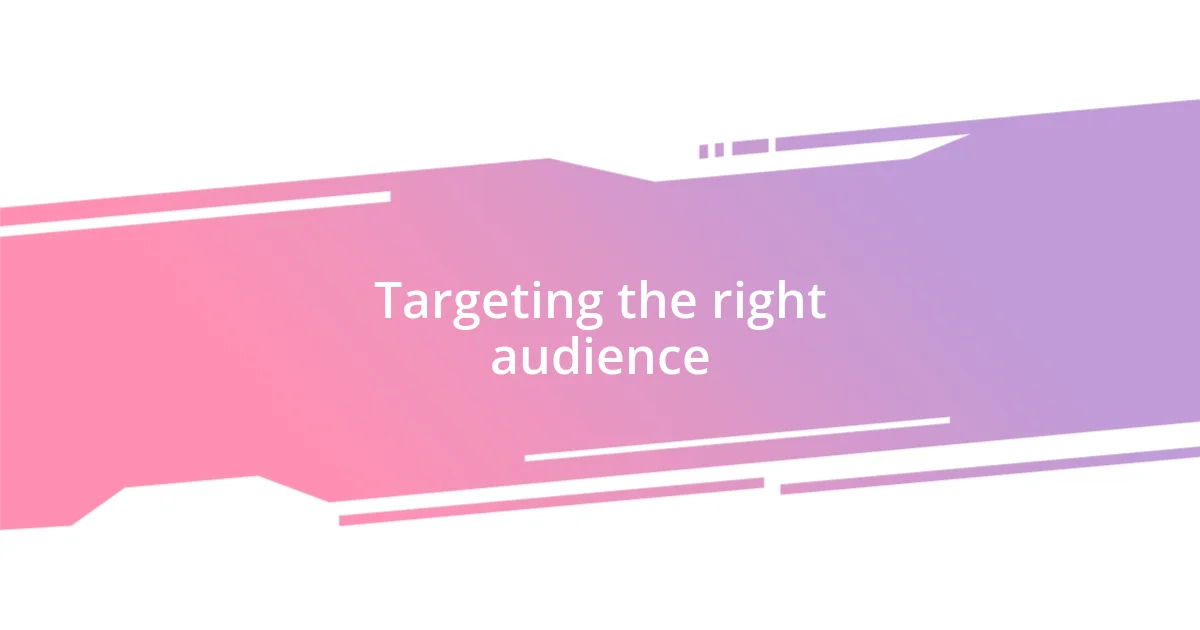
Targeting the right audience
Finding the right audience on Instagram transformed my ad campaigns completely. At first, I cast a wide net, only to watch my posts fade into the background. Once I started using Instagram’s targeting tools to hone in on specific demographics—like age, location, and interests—I felt a surge of confidence. Suddenly, my content started resonating; it was as if I was finally speaking directly to the hearts of potential customers who truly cared.
Here are some crucial strategies I’ve discovered for effective audience targeting:
- Demographics: Consider age, gender, and location; tailor your ads based on where your ideal customers live and their age range.
- Interests and Behaviors: Use interest-based targeting to reach users who engage with content similar to yours.
- Lookalike Audiences: Leverage data from current customers to find new, similar audiences who may also connect with your brand.
- Custom Audiences: Target users who have already interacted with your brand, whether through website visits or engagement with previous ads.
I remember placing a campaign aimed at outdoor enthusiasts, focusing on a specific region. The response was overwhelming! It felt incredible to get positive comments from people who shared my passion for nature. By targeting precisely, it became clear that I wasn’t just throwing ads into the abyss; I was building a community around mutual interests. That connection brought me a sense of purpose that I hadn’t anticipated but deeply appreciated.
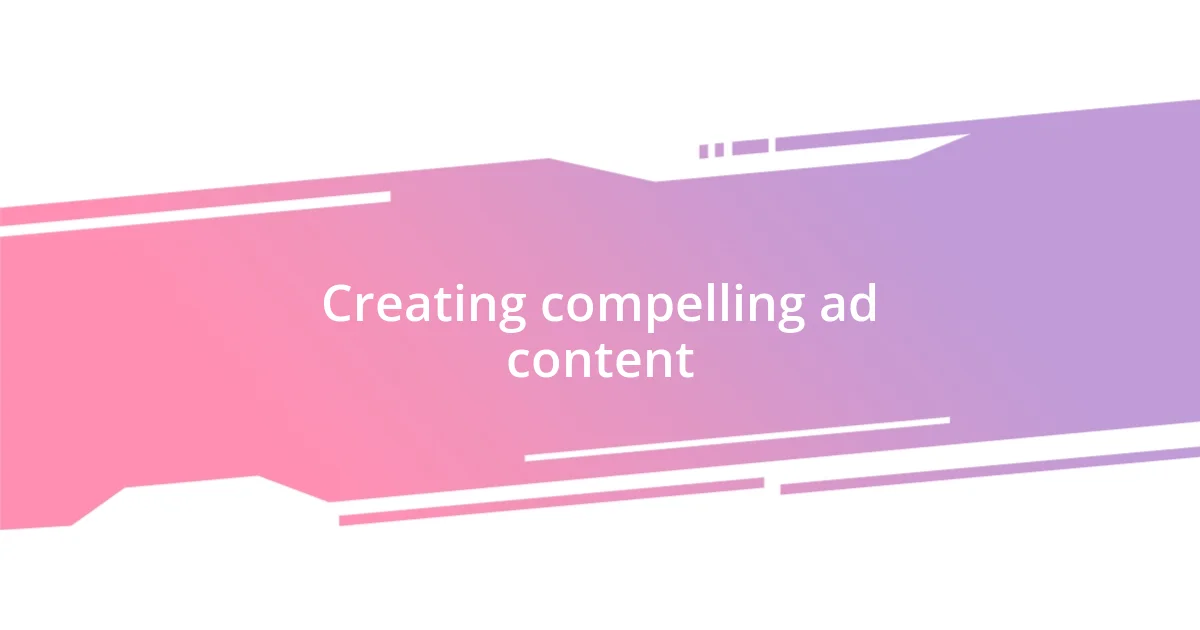
Creating compelling ad content
Creating compelling ad content means stepping into the shoes of your audience. I remember the first time I crafted an ad that truly resonated with people. I used bright, relatable images paired with genuine testimonials. The result was astounding—engagement shot up! It made me realize that when we present authentic stories and visuals, we aren’t just selling a product; we’re sharing an experience.
A compelling ad also often hinges on the right message. One campaign I ran featured a fun, playful tone, which perfectly matched the spirit of our brand. But there was a twist—I also included a heartfelt call-to-action that invited people to share their stories with us. This dual approach not only highlighted our offerings but also encouraged community involvement. Have you considered how your tone of voice might draw in your audience?
Another key lesson I learned involved testing different formats. I experimented with Instagram Stories, carousel posts, and single-image ads to see what caught users’ eyes most effectively. I was amazed by how a simple shift in format could revive a campaign that felt stagnant. It’s a reminder that adaptability is essential. Are you trying different formats to keep your audience engaged? After all, discovering what works can lead to unexpected successes and refreshed enthusiasm.
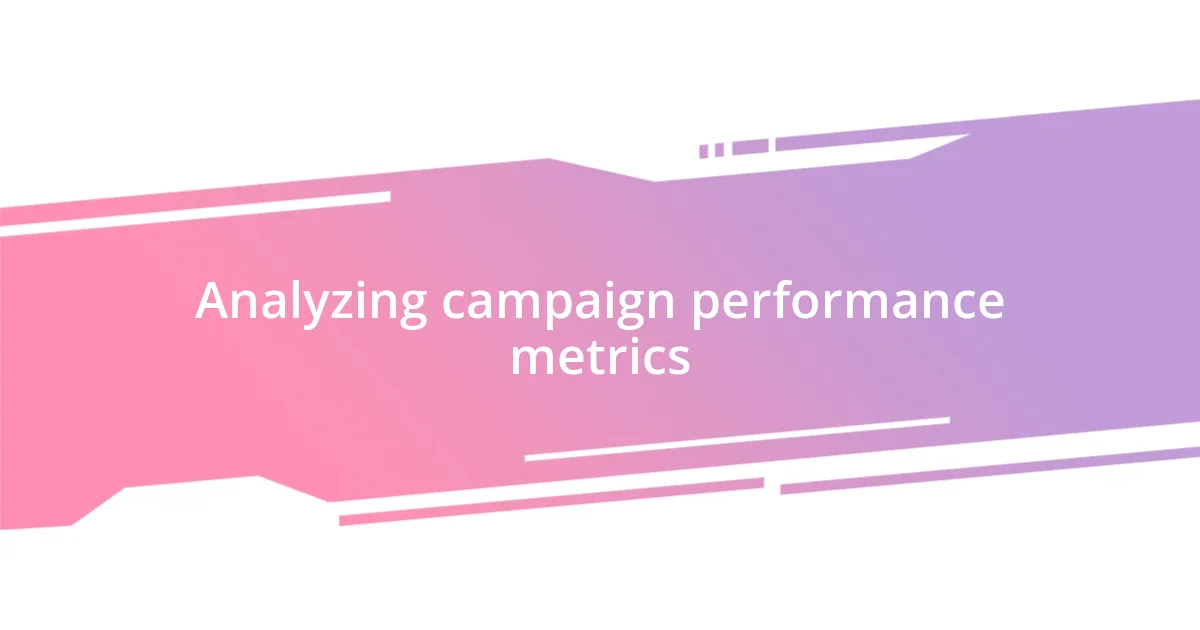
Analyzing campaign performance metrics
When it comes to analyzing campaign performance metrics, I find that paying close attention to the data can be a game changer. One campaign I ran had potential, but the metrics told a different story. At first glance, the engagement numbers seemed decent, but I realized that my click-through rate was alarmingly low. This experience taught me that surface-level results can sometimes mask deeper issues—what looked good on the outside didn’t translate into action. Have you had a moment like that, where the numbers made you rethink your strategy?
Diving deeper into metrics like return on ad spend (ROAS) and cost per acquisition (CPA) allowed me to refine my approach further. I remember one particularly challenging campaign where the CPA was far too high for my comfort—this was my wake-up call. It wasn’t just about how many people were seeing the ads; it was about how many were genuinely interested in my product. By reevaluating the creative elements and tweaking the audience targeting, I managed to lower the CPA significantly. How often do you check your CPA to ensure you’re getting the most bang for your buck?
It’s also worth mentioning the importance of A/B testing in understanding performance metrics. For one campaign, I split-tested various headlines and images, which led to surprising insights. I discovered that a more straightforward visual outperformed a flashy one by a significant margin. This process wasn’t just about numbers; it felt like I was peeling back layers to find what truly resonated with my audience. Have you explored this kind of testing? It can be enlightening to see which elements connect with people, often leading to better overall performance.
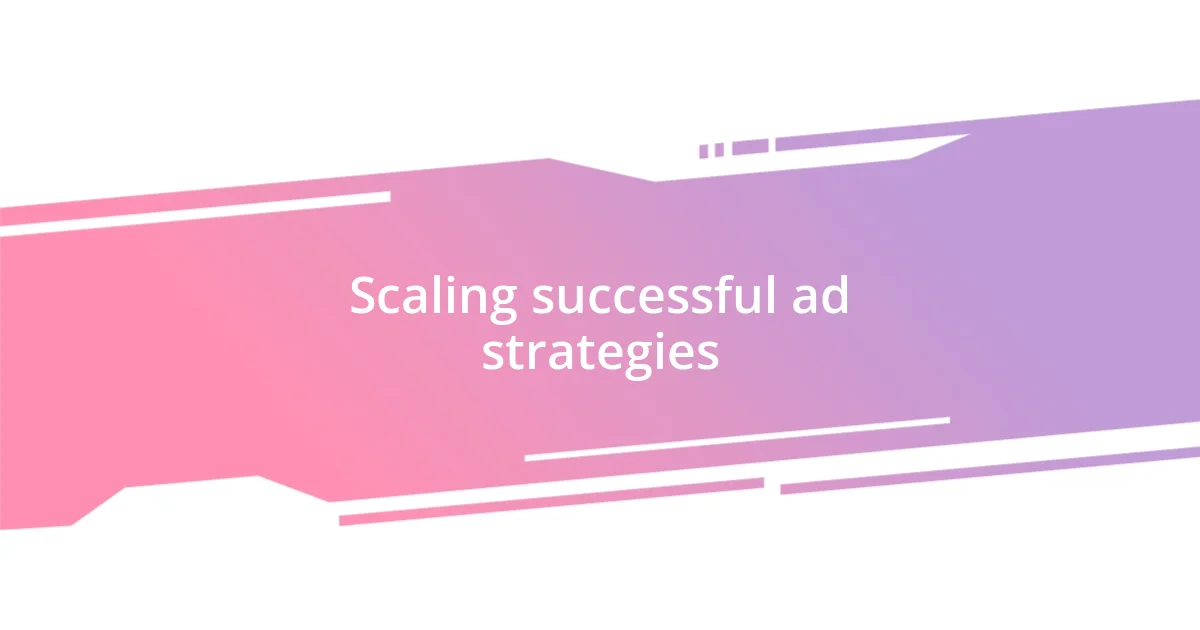
Scaling successful ad strategies
Scaling successful ad strategies requires a keen insight into what has previously worked. In one of my earlier campaigns, I noticed certain target demographics consistently engaged with our ads more than others. By doubling down on that segment, refining our messaging and visuals specifically for them, we not only expanded our reach but also dramatically increased our conversion rates. It was like striking gold! Have you ever experienced that rush when you realize you’re reaching the right audience with just the right message?
I also learned to embrace the power of automation as I scaled. Setting up automated rules to pause underperforming ads and increase budgets on those that excelled was a game-changer for me. For example, there was a moment when an ad began to gain traction unexpectedly—by the time I noticed, it had already doubled in performance. That automated boost allowed me to capitalize on the momentum effortlessly. Wouldn’t it be nice to have more time to focus on creativity instead of constantly monitoring every ad?
Another significant aspect I discovered was the importance of aggregating insights across campaigns. Each experience, each little success or failure, offered valuable data to shape future strategies. I remember looking back at my best-performing campaigns, identifying patterns, and, believe it or not, replicating them in different contexts. This iterative approach became my secret weapon. Have you taken the time to analyze your past campaigns to inform your future efforts? It can be incredibly enlightening!
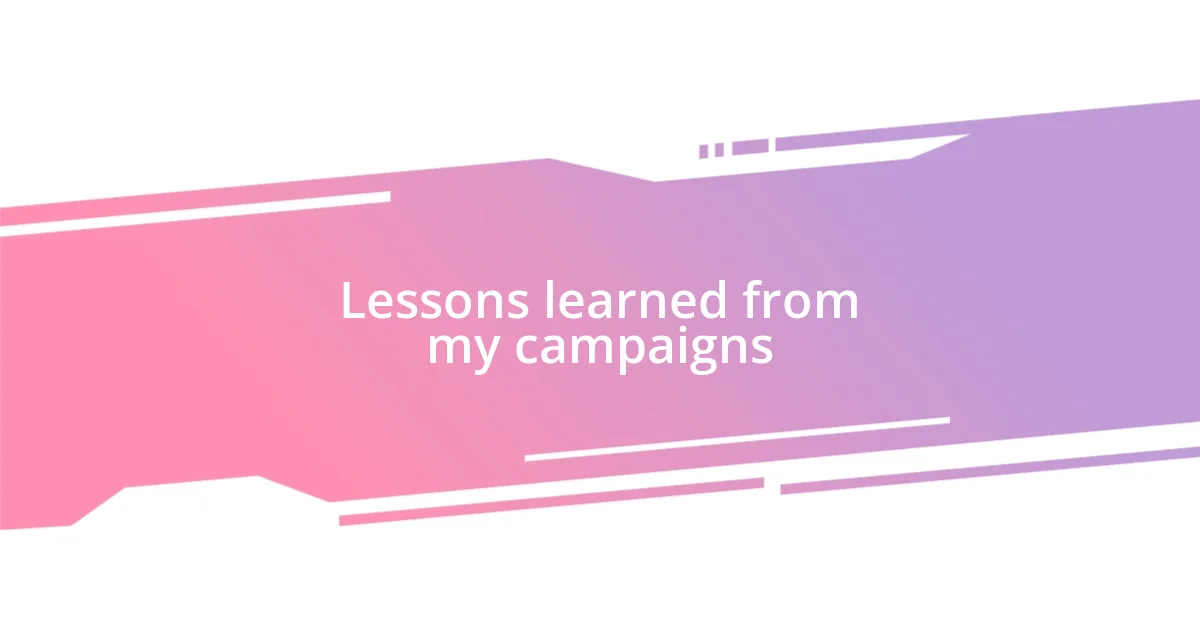
Lessons learned from my campaigns
One major lesson I gleaned from my campaigns is the crucial role of storytelling. I recall one particular ad that focused solely on product features—it fell flat. When I shifted my approach to weave in a relatable narrative, the engagement skyrocketed. Storytelling creates a connection with the audience that facts alone simply cannot achieve. Have you ever noticed how certain ads stick in your mind because they tell a story rather than just selling?
Another insight I gained was the necessity of adapting quickly to feedback. There was a time when a campaign I launched didn’t resonate as expected; the comments were overwhelmingly critical. Instead of getting defensive, I took a deep breath and listened. By making adjustments based on audience feedback, I transformed a struggling campaign into a success story. That experience taught me the importance of humility and responsiveness in marketing. How do you handle criticism when it comes to your ads?
Lastly, I learned that timing can be everything. I remember rolling out an ad during a holiday season without fully considering my audience’s competing interests. The initial response was lukewarm, and I realized it was about more than just the content—it was about the context. By fine-tuning my campaign timing and aligning it with audience behaviors, I was able to create a sense of urgency and relevance. Have you ever found that timing changed the whole dynamic of your campaign? It’s fascinating how such a simple shift can make all the difference!










